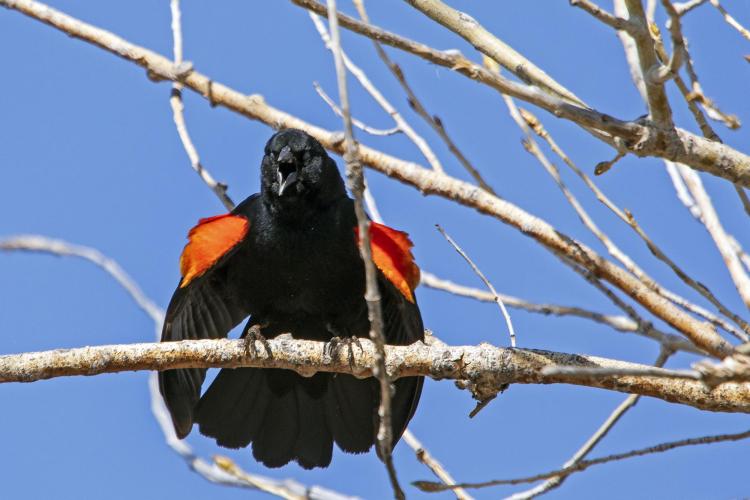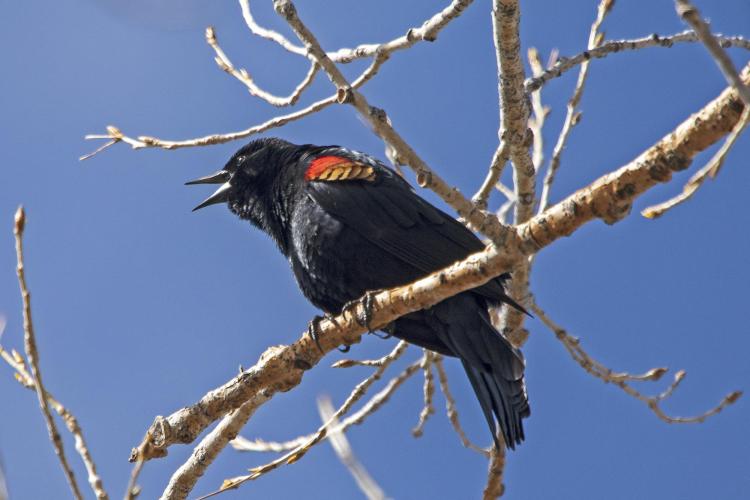Conflict and vigilance among red-winged blackbirds
The song spread is critically important in defense of a territory and the song is also evaluated by females as a facet of courting
From the branch above me, a male red-winged blackbird took a deep breath, hunched up his shoulders, flared the feathers on his epaulets and let out a loud threat directed at his neighbors and non-territorial males looking for an opportunity. He repeated this "song spread" call and display, avian for "no trespassing," four more times before moving to another conspicuous perch on the margin of his territory. These calls, familiar harbingers of spring, rang out from marshes on both sides of the South Boulder Creek Trail.
While the drama of a blackbird marsh is entertaining at any level, I like to view the action through the lens of an evolutionary biologist, who interprets incentives and strategies in terms of reproductive success or fitness, the common metric of natural selection and sexual selection (natural selection in the context of reproduction). For example, red-wing blackbirds, Agelaius phoeniceus, are sexually dimorphic. Males are jet black with epaulets, or shoulder patches, that are bright red with a fringe of yellow at the lower margin. Females are many shades of cream, gray and brown, with striping that is cryptic in grasses and cattails. Sexual dimorphism marked by larger or outrageously colored males is typically found in polygynous species in which one male earns access to several to many females. Cryptic coloration allows females to avoid predators, but males must be outrageous to intimidate male competitors and attract females. In monogamous species, a male and a female work as a team to raise offspring for which they gain equal amounts of fitness, but polygyny is marked by disparate fitnesses and therefore conflicting male and female strategies.
Males arrive in the marshes first in spring, with the immediate goal of securing a breeding territory, for virtually all of the mating is accomplished by males with territories. They must be calculating and judicious, for although a bigger territory can support more females, the effort needed to defend a territory increases with its size. A male's second goal is to court females to nest in his territory. The number of females within a male's territory varies from one to fifteen. But each bird has a finite amount of energy and both territorial defense and courting require energy, so a male must find a balance of defense and acquisition of mates.

A strident song and menacing posture marks his territory. Photo by Jeff Mitton.
The song spread is critically important in defense of a territory and the song is also evaluated by females as a facet of courting. Experimental studies have used black marker to temporarily hide the red and yellow epaulets in males defending a territory and darkened males soon lost their territories. Similarly, when territorial males were surgically altered to silence their singing, they lost their territories. This result might depend on blackbird density, for a second study in a sparser population failed to achieve the same results. But clearly, the epaulets, display and song are all needed for male fitness.
Females arriving at the marsh in spring must first choose a territory, but many factors must be considered. She must evaluate the size and quality of each male's territory, as well as how much space she can secure in his breeding territory for her feeding territory. But in addition, females prefer larger, older males that have had territories in previous years, and who put a lot of energy into courting.
The bedlam of a marsh packed with red-winged blackbirds singing, displaying and chasing is entertaining, but even more so when one appreciates the incentives and strategies motivating behaviors."
An individual's behavior has been tuned by natural selection to do things that maximize individual fitness. Polygynous mating systems invariably generate conflict when decisions that benefit male fitness diminish female fitness. For example, a male will attract as many females as possible to his territory because each additional female will enhance his fitness. But packing more females into a finite space diminishes the food available to each, reducing either the number of eggs she can lay or the number of chicks she can fledge. Indeed, as the number of females already on the territory increases, it becomes increasingly difficult to add more females, for each is reluctant to reduce fitness by accepting an inadequate feeding territory.
The bedlam of a marsh packed with red-winged blackbirds singing, displaying and chasing is entertaining, but even more so when one appreciates the incentives and strategies motivating behaviors. For example, territorial defense continues through most of summer, for females may attempt a second brood, and then a third. So, females are available all summer and genetic studies of paternity revealed that approximately one blackbird in four was the product of an extra-pair fertilization, accomplished either by a male on an adjacent territory or an opportunistic non-territorial male. The cost of paternity is eternal vigilance.

A strident song and menacing posture marks his territory. Photo by Jeff Mitton.

